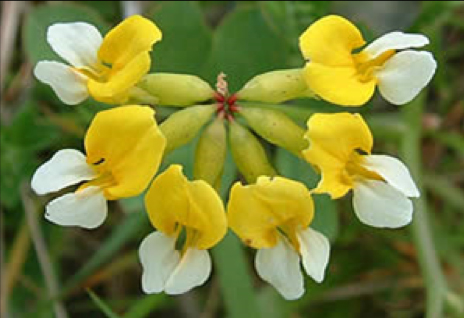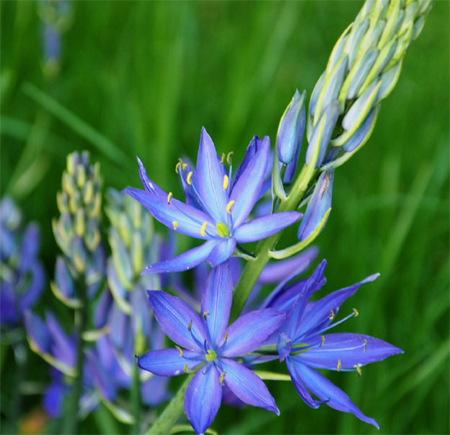 | NATIVE SUN PLANT Camas (Camassia leichtlinii) or Wild Hyacinth - Perennial herb (from bulb). Centre stem yields beautiful vibrant purple flower stalk, April to June. Historically were found widespread, but now declining.
- Prefers moist to average meadows, gently sloping hills. Full sun to partial shade.
- Bulbs were an important food source to First Nations people of Vancouver Island. They were ground, mixed with berries and dried into "pancakes."
- Not to be mistaken with white flowering Meadow Death Camas which is toxic.
|
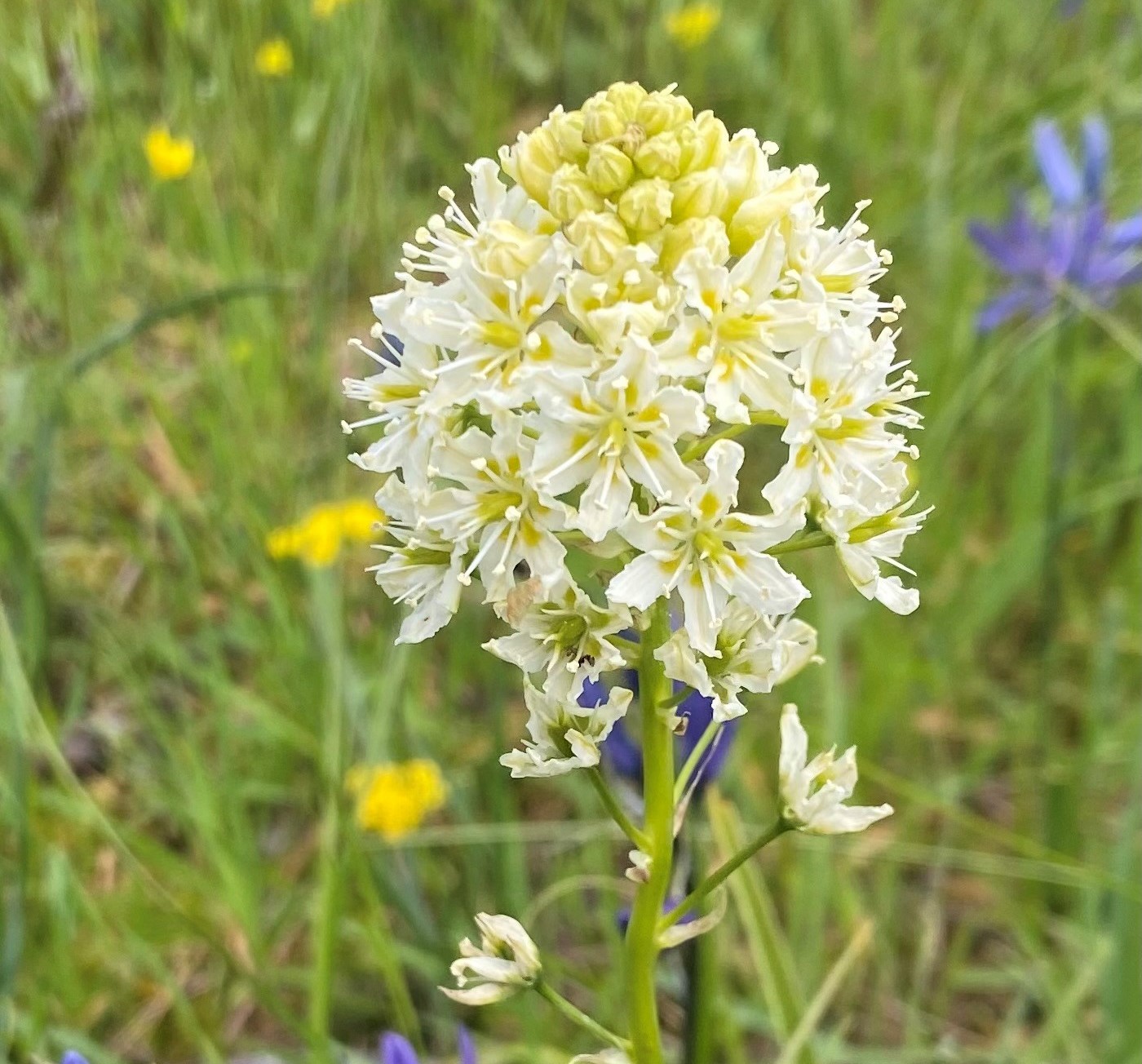 | NATIVE SUN PLANT Meadow Death Camas (Zigadenus venenosus) - Perennial (from bulb). Erect stem, shiny grass like leaves 4-15 in long, edged with stiff hairs. The stem terminates in a raceme of cream to white 6 petaled flowers.
- It flowers April to June.
- Prefers moist to average meadows, gently sloping hills. Full sun to partial shade.
- The mature leaves and bulbs of this plant are very toxic and should not be ingested.
|
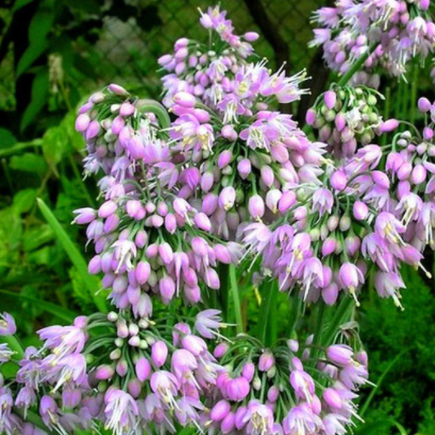 | NATIVE SUN PLANT Nodding Onion (Allium cernuum) - A drift of this long-lasting lily lures pollinators and butterflies for months.
- Handles salt spray, wind, drought & poor, gravelly soils.
- Best for dry open woods, exposed sandy meadows and rock gardens where it spreads quickly.
- First Nations people ate the leaves and bulbs either raw, cooked or dried because of the strong flavour.
|
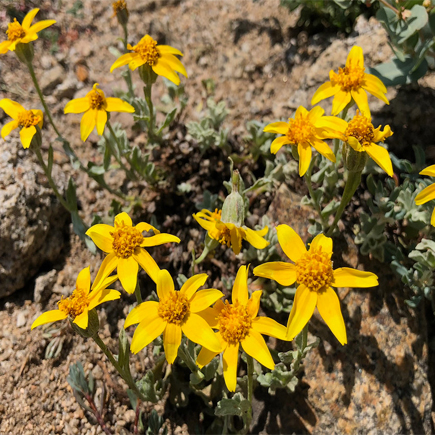 | NATIVE SUN PLANT Woolly Sunflower (Eriophyllum lanatum) - Perennial herb 10-60 cm tall, with light grey green, velvety foliage and intense, yellow flowers that bloom from May to August attracting bees and butterflies.
- Prefers dry shallow, well-drained soil and full sun, but also grows on rocky slopes and bluffs.
- Various First Nations people used this plant for medicinal purposes: using the leaves as a poultice and binding them to aching parts of the body; or rubbing the leaves on skin to prevent chapping; or drying the flowers and using as a love charm.
|
 | NATIVE SUN PLANT Red Columbine (Aquilegia formosa) - Herbaceous Perennial herb with taproot.
- Delicate lobed leaves with breathtaking red, yellow fluted flowers to '2.
- Prefers full sun/part shade and found in a conifer or mixed forest in openings or meadows.
- Attracts Birds (seeds), Hummingbirds, Butterfly adult (nectar).
- First Nations people had used various parts of this plant for medicinal purposes such as an antispasmodic, a diaphoric, a parasiticide and a salve or hair wash.
|
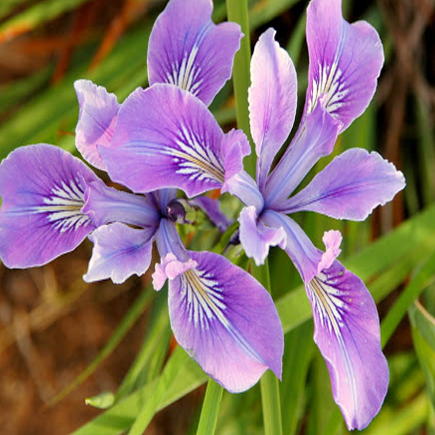 | NATIVE SUN PLANT Oregon Iris (Iris tenax) - Perennial, rhizome to 1'. Beautiful, large purple flower with white-yellow streaks and ruffled inner petals. Blooms mid to late spring.
- The leaves are very slender and grass like – 5 mm broad.
- Found in sunny open woodlands, meadows, pastures and roadsides with acidic soil.
- First Nations people used fibrous leaves for braiding into snares and other cordage.
|
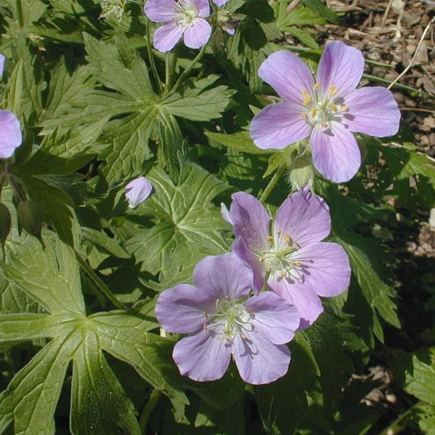 | NATIVE SUN PLANT Wild Geranium (Geranium maculatum) - Rhizomatous perennial herbaceous plant growing to 2’ tall, producing upright usually unbranched stems and flowers in spring to early summer.
- The leaves are palmately lobed with five or seven deeply cut lobes. The flowers are 2.5–4 cm in diameter, with five rose-purple, pale or violet-purple petals blooming April to June.
- First Nations people used this plant as an astringent, to stops tissue bleeding, to help with toothaches, painful nerves and for treating hemorrhoids.
|
 | NATIVE SUN PLANT Kinnikinnick (Arctostaphylos uva-ursi) aka Bearberry - An early blooming, trailing evergreen ground cover with dark green, leathery leaves and red berries in winter for birds. Fruit looks like little apples.
- Grows in dry, sunny or sandy slopes. Creeping branches cover walls and tolerate foot traffic.
- A caterpillar host and hummingbird feeder, this plant dresses up any site.
- Used by First Nations people in their smoking mixes and the berries used to treat bladder and kidney disorders.
|
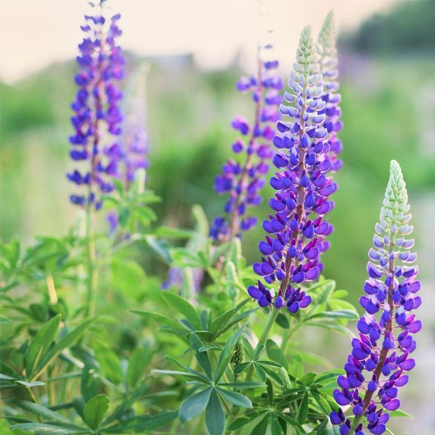 | NATIVE SUN PLANT Lupine (Lupinus) - Perennial, branched rhizome. Distinct palmate grey-green leaf, 10-15 leaflets. Purple flowers in linear, vertical clusters.
- Found in low to mid-elevations, in open meadows, disturbed sites (road cuts), shorelines.
- Prefer moist to average soil. Fixes nitrogen levels in the soil.
- Widely cultivated as a food source (legume family) and as an ornamental plant by First Nations people.
|
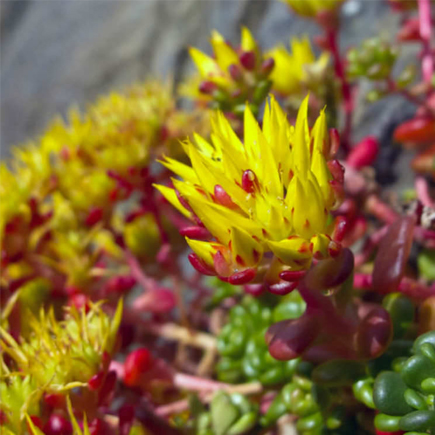 | NATIVE SUN PLANT Oregon Stone Crop (Sedum spathulifolium) - Perennial "sedum." succulent, rhizomal, spreading.
- Edible, succulent leaves range from waxy sage green to crimson red.
- Bears small yellow to pink flowers, which attract pollinators and hummingbirds.
- Found in well-drained sandy or rocky locations. Often at edge of forest and areas of high precipitation.
|
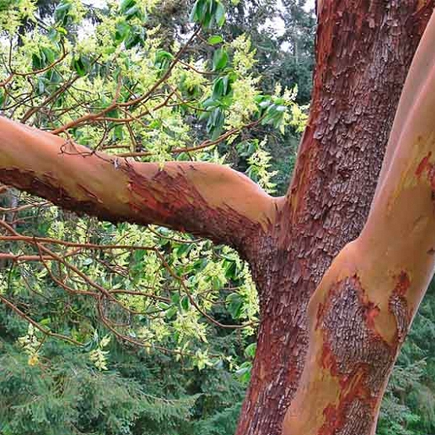 | NATIVE SHRUBS AND TREES Arbutus (Arbutus menziesii) aka Strawberry Tree - Can grow up to 30 metres tall, usually with a crooked or leaning trunk that divides into several twisting upright branches and an irregularly rounded crown. It has dark glossy broad leaves with reddish brown thin bark that peels in thin strips.
- Dense clusters of urn shaped white waxy flowers droop in April and May, leading to reddish orange berry like fruit in October.
- Prefers rocky or rapidly drained soils, open sunny locations and rocky bluffs.
- First Nations people of Vancouver Island used the bark & leaves to create medicines for colds, stomach problems, and tuberculosis, and contraceptives.
|
 | NATIVE SHRUBS AND TREES Vine Maple (Acer circinatum) - Mid to large sized multi-branched deciduous shrub or tree 10-15’. Beautiful and delicate looking. Leaves are palmate, small, 7-9 pointed lobes, attractive red to yellow autumn colors.
- Small white flowers at end of shoots. Winged seed.
- Found in moist to dry soils. Understory and edge of conifer or mixed forests. Prefers shade.
- First Nations people historically used the dense and hard, yet flexible wood of the vine maple for snowshoe frames, drum hoops and small utensils, such as spoons and dishes.
|
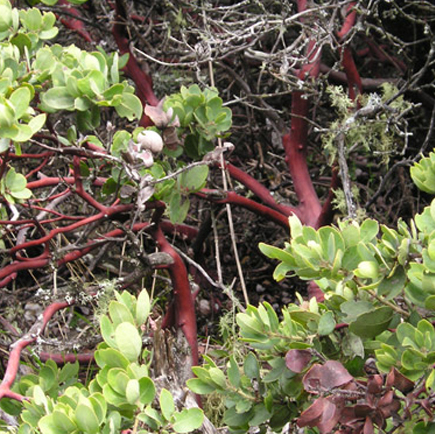 | NATIVE SHRUBS AND TREES Manzanita (Arctostaphylos adans) - Every green shrub found in rocky areas and steep slopes with poor soil and little water.
- Characterized by smooth orange, red, or blackish brown bark and stiff, twisting branches.
- Manzanitas bloom in the winter to early spring and carry berries in spring and summer.
- The flowers and berries (which look like little apples) of most species are edible.
- First Nations people made jelly from the berries and herbal teas from the leaves. The leaves contain chemicals useful to treat poison oak rash and mild urinary tract infections.
|
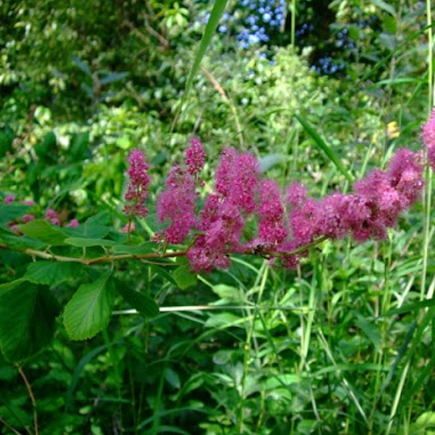 | NATIVE SHRUBS AND TREES Hardhack (Spiraea Douglasii) - Small deciduous shrub with multiple erect branches. Small leaves. Dramatic "spear head" purple flower spikes that bloom in July & August.
- Found in wet, moist and average soils, often at streamside areas and lakes. Occasionally at drier, partially shaded sites. Spreads by rhizomes very quickly and aggressively.
- Some First Nations people used Douglas Spiraea for spreading and cooking salmon and for making tools to collect shells for trade and decoration.
|
 | NATIVE SHRUBS AND TREES Indian Plum (Oemleria cerasiformis) aka Oso Berry - Mid-size deciduous shrub. Branches thin and arching. Separate male and female plants. String of beautiful fluted fragrant white flowers in early March, yielding thumbnail sized peach to purple colored berries with pits. Berries liked by native birds and critters.
- Found in Conifer and mixed forests. Often at edges or under canopy. Does not tolerate direct sunlight well.
- First Nations people used the Indian Plum for food and medicine.
|
 | NATIVE SHRUBS AND TREES Mock Orange (Philadelphus lewisii) - Mid-sized deciduous shrub with fragrant white flowers blooming in early to mid-summer.
- Found in varied terrain. Found in open forests and forest edge and in drier, bushier sites. Low to mid elevation. Tolerates sun but prefers part shade.
- Enjoyed by Birds, Butterfly adult, Butterfly larvae. Poisonous seeds.
- First Nations people used the hard wood for making hunting & fishing tools, pipes, snow-shoes, furniture, etc. Leaves & flowers formed a soapy lather or used in perfumes and teas.
|
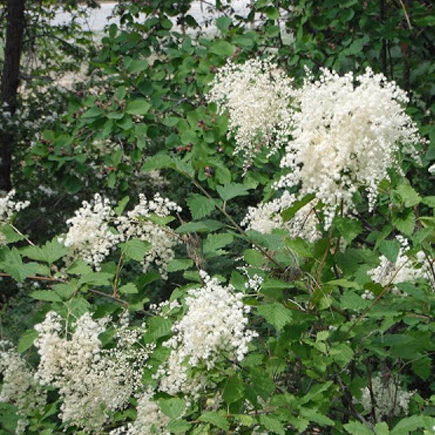 | NATIVE SHRUBS AND TREES Oceanspray (Holodiscus discolor) - This beautiful shrub (3-15’) thrives in poor soils, rocky dry sites in partial to full sun, and salt spray, attracting seed-eating birds.
- The leaves, lobed and triangular, are ¾” – 2 ½” long. The fragrant flower buds form dense, cream-colored clusters of tiny droplets that bloom for many weeks between May and July.
- First Nations people used this exceptionally hard, strong wood to fashion arrows, harpoons, digging tools, sharp pins and even awls for sewing and beadwork. Because the wood does not burn readily, it was also used to make cooking tools and spits for roasting salmon.
|
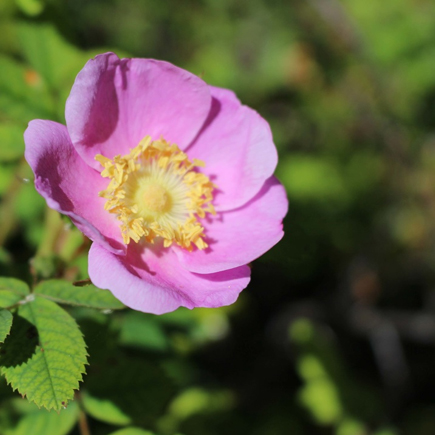 | NATIVE SHRUBS AND TREES Nootka Rose (Rosa nutkana) - One of several native roses. Small to mid-sized, deciduous. With 5-7 toothed leaflets.
- Charming five broad, petalled pink flowers, yielding to bright orange pear shaped rose hips.
- Likes full sun to part shade. Tolerates seasonal dry.
- Loved by Birds, Butterflies and leaf-cutter bee.
- First Nations people used the Nootka Rose as a food, medicine and building material. The hips were cooked and fed to children with diarrhea. A tonic tea was made from the petals, leaves, branches and inner bark. The leaves were also used as a poultice for bee stings.
|
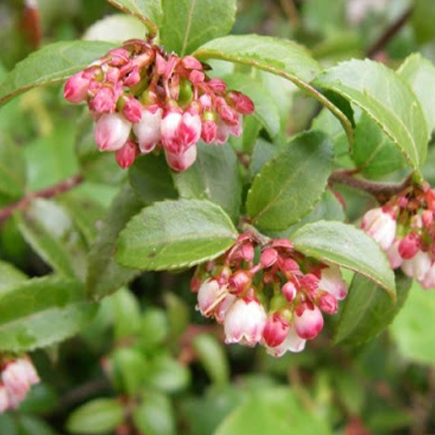 | NATIVE SHRUBS AND TREES Evergreen Huckleberry (Vaccinium ovatum) - Mid-size evergreen shrub. Erect, bushy, dark shiny green, irregularly toothed leaves. Pink 1 cm bell shaped flowers, 3-10 per cluster, yielding shiny, sweet purplish-black 1 cm berries.
- Found in Coniferous and mixed forests, often at edges and openings. Low elevation.
- Loved by hummingbirds and happy in sun or shade.
- Charming evergreen with pretty flowers and edible fruit. A favorite amongst the First Nations people used in jams and pies.
|
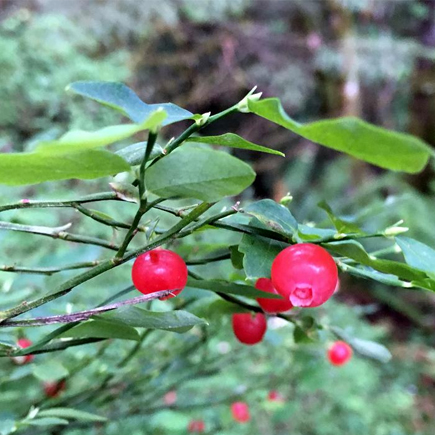 | NATIVE SHRUBS AND TREES Red Huckleberry (Vaccinium parvifolium) - Mid-size deciduous shrub. Erect with bright green, angled branches.
- Alternate, oval, non-toothed, 1" leaves with yellow to pink bell-shaped flower, yielding bright red, tasty rounded berries - eaten fresh or dried.
- Found in Conifer and mixed forests, often at edges or under canopy – light to semi shade.
- Prefers light sandy well-drained soils with decaying wood. Low to middle elevations.
- The First Nations people also brewed the bark or leaves and used in a tea or smoked as a bitter cold remedy. The branches were used as brooms and the twigs as fasteners.
|
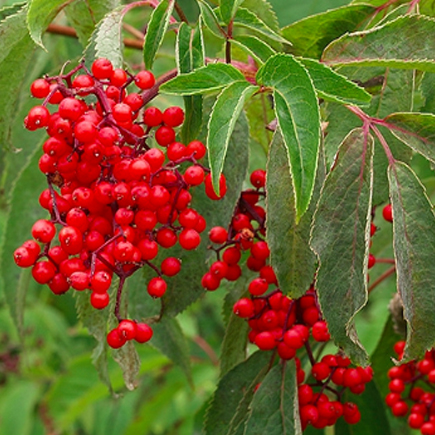 | NATIVE SHRUBS AND TREES Red Elderberry (Sambucus Racemosa) - Beautiful mid to large sized deciduous shrub with multiple erect, spreading and curved branches.
- Compound leaves with 5-7 leaflets 2-5". Floral stems with many small whitish flowers, yielding to rounded pyramid of red berries.
- Good food for birds, deer and small mammals.
- Found in conifer and mixed forest at openings in canopy. Does not tolerate well direct sunlight. Sea level to mid elevations.
- First Nations people used cooked flowers and berries for jam and medicinal purposes, however, raw berries and seeds should not be eaten.
|
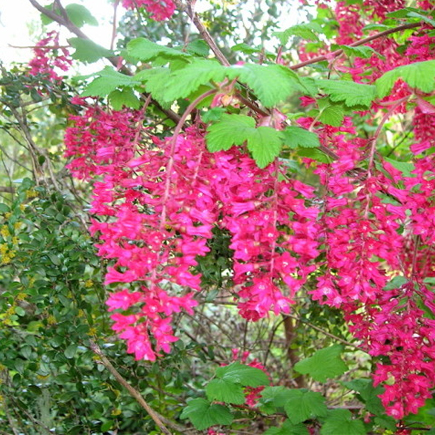 | NATIVE SHRUBS AND TREES Red Flowering Currant (Ribes sanquineum) - Hummingbirds feed from brilliant pink to red blooms in the spring, and other birds enjoy black currants in the fall.
- Beautiful mid size (8-10’) deciduous shrub. Erect, spreading branches with beautiful "stalks" (linear clusters) of small red flowers.
- Found widespread in average to dry soils. Prefers open forests, clearings and disturbed sites.
- The berries were eaten fresh by some First Nations people, but not considered very tasty.
|
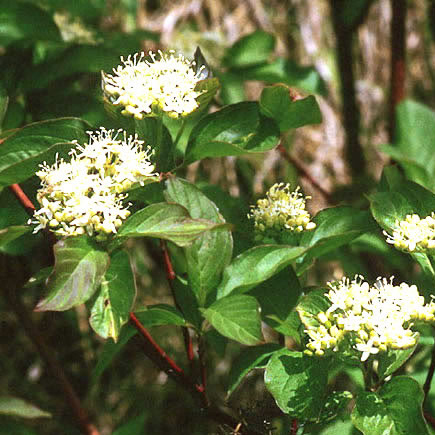 | NATIVE SHRUBS AND TREES Red Osier Dogwood (Cornus sericea) - Mid-size deciduous shrub. Straight, spreading branches. Grows rapidly in sun or shade to 15’.
- Leaves are opposite with parallel tapering veins turning crimson in fall. Branches terminate in cluster of small white flowers May to July, yielding white berries. Young stems are brilliant red, with deep purplish fall color. Important winter food for deer and elk.
- Found in moist to dry soils, open forests, stream sides and brushy areas. This plant spreads by runners, important in holding soil, slowing water flow and increasing sedimentation.
- First Nations people used the inner bark and leaves in tobacco mixtures. The bark was also used as relief for weak kidneys or poison ivy, an anti-diarrheal and as a pediatric aid for bed wetting. The stems were used to make dreamcatchers, arrows, stakes and other tools.
|
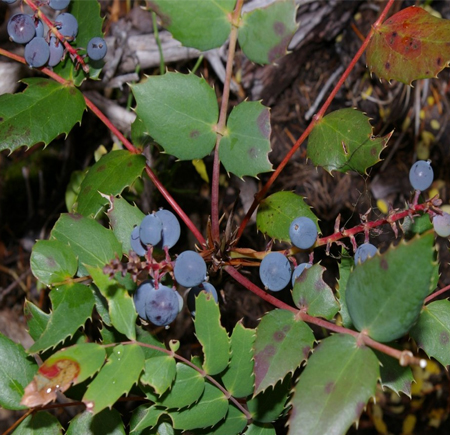 | NATIVE SHRUBS AND TREES Dull Oregon Grape (Mahonia nervosa) - Oregon Grape grows 2-3' tall and flourishes in sun or shade and is highly drought tolerant.
- In spring, large clusters of small golden flowers unfurl from shiny green, holly-like foliage.
- New growth is copper color in the spring.
- The blue edible, fruits are tart and improve after frost. They are often gathered for jelly or wine. Birds and small wildlife are attracted to these berries.
- The Oregon Grape root is used as a medicinal herb and a staple diet by First Nations people, curing many diseases and ailments of the gastro intestinal system.
|
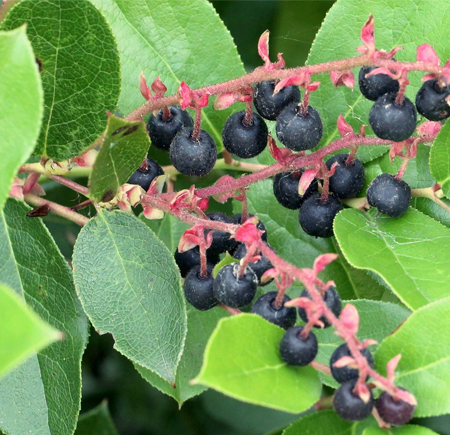 | NATIVE SHRUBS AND TREES Salal (Gaultheria shallon) - Small size evergreen shrub 2-6’. Creeping to erect growth.
- Alternate, shiny, round leaves with tip, 2-4". 5-15 urn-shaped 1 cm flowers at end of branches, yielding bluish 1 cm berries, attracting birds and butterflies.
- Salal is extremely adaptable, thriving in sun, shade, humus, infertile, dry or moist soils. It requires little care once established.
- The berries were a significant food resource for First Nations people, fresh and dried. They were also used as a sweetener, and the Haida used them to thicken salmon eggs.
|
 | NATIVE SHRUBS AND TREES Snowberry (Symphoricarpos albus) aka Waxberry - Small deciduous shrub growing 2-4’ and spreading rapidly. Discreet, pink-white, bell shaped flowers adorn the delicate, thin twigs. Hummingbirds feed on the nectar. Large white berries last through the winter and although poisonous to humans, are delicious for birds and other wildlife.
- The leaves grow in pairs and have a lovely blue tint.
- Found widespread in shady and moist mountain and forest habitat and along riverbanks.
- Used by First Nations people as an external wash, killing parasites and healing wounds.
|
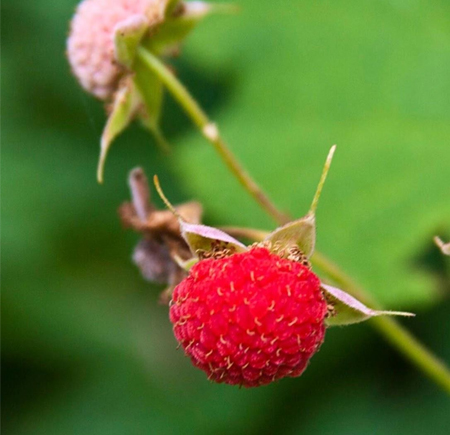 | NATIVE SHRUBS AND TREES Thimbleberry (Rubus parvifolius) - Small to mid-sized deciduous shrub - erect, mildly spreading thornless branches.
- Soft, "maple" shaped leaves, 4-6" with white 1+" flowers in small clusters.
- Thimbleberry fruits are smaller, flatter, and softer than raspberries, and have many seeds.
- Found in coastal, valley and foothill forests. Often in open sites or at forest edge.
- Many First Nations people harvested Thimbleberries, using the leaves for tea, the berries as an excellent source of vitamin C and the sprouts, peeled and eaten raw as a vegetable.
|
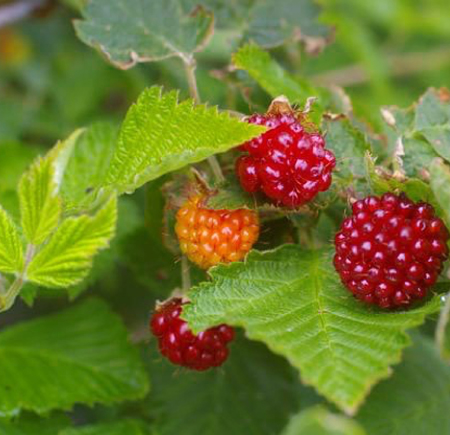 | NATIVE SHRUBS AND TREES Salmonberry (Rubus spectabilis) - Mid-sized fast growing deciduous shrub, standing up to 6’ tall by 6’ wide.
- Large, reddish purple flowers give way to yellow rose tinted, edible berries.
- Important in bank stabilization & a nesting spot for birds & small mammals.
- Found in sunny or part shaded forest or riparian areas, usually following a disturbance.
- First Nations people historically used the roots to help stimulate appetite, and the leaves to treat anemia, ease labor pains or chewed to cure diarrhea or an upset stomach.
|
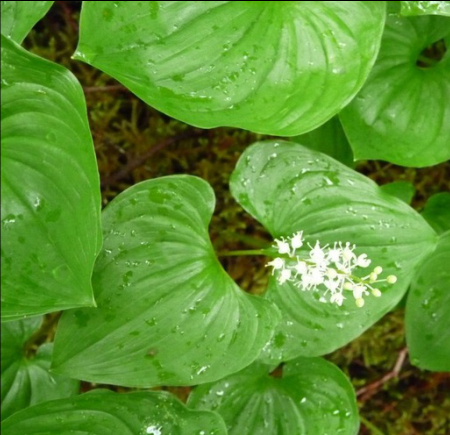 | NATIVE SHADE PLANT False Lily of the Valley/False Solomon's Seal (Maianthemum dilatiatum/racemosum) - Perennial rhizome, unbranched stems (False Lily of the Valley) or arching stems (False Solomon’s Seal).
- Low, shade-loving groundcover with drifts of shiny heart to arrow shaped leaves and white perfumed flower cluster yields green to red berries.
- Found in moist forests, meadows and clearings, riversides. Lowlands to subalpine.
- First Nation people traditionally used the leaves and/or roots on cuts, rubbed on sore eyes or made into juice for internal injuries or to reverse sterility.
|
 | NATIVE SHADE PLANT Fringe Cup (Tellima grandiflora) - Beautiful, graceful Herbaceous perennial with short rhizome and found in Conifer and mixed forests, usually in moist open areas.
- This unique flower has several basal, maple style leaves with five lobes and rounded teeth along the margin and attracts hummingbirds and other pollinators.
- Flower shoots of small, white to pink bell-shaped flowers. “Fringe cup” describes the flower where the petals, highly divided, create a fringe around the floral cup.
|
 | NATIVE SHADE PLANT Pacific Bleeding Heart (Dicentra formosa) - Herbaceous fern like perennial, rhizome with deeply cut leaflets.
- Beautiful heart shaped red/pink and white flowers on drooping stem 1-1.5’.
- Prefers part shade to full sun and can be found in moist forest understory, openings or riparian zones.
- Attracts hummingbirds, butterflies and ants.
- Although foliage is toxic if ingested, traditionally First Nations people have used this plant as a remedy for toothaches, other pains and for treating syphilis.
|
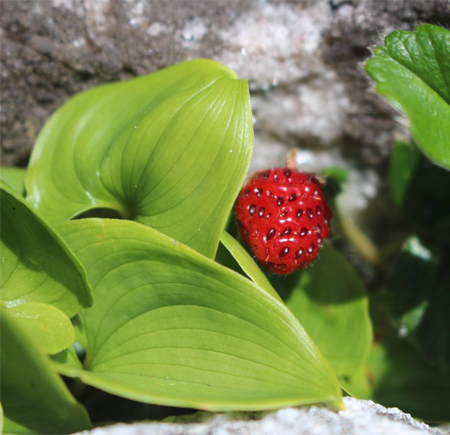 | NATIVE SHADE PLANT Woodland or Coastal Strawberry (Fragaria vesca/chiloensis) - Perennial herbaceous low growing herb from the rose family with waxy green leaves
- Five to eleven soft, hairy white flowers are borne on a green, soft-hairy stalk that usually lifts them above the leaves. The light-green leaves are trifoliate (in threes) with toothed margins. The plant spreads by means of runners.
- Produces thumbnail size edible red strawberries.
- Found in coastal well-drained sandy sites, sand dunes, bluffs, woodland and at forest edges and openings. Prefer sun to part shade
|
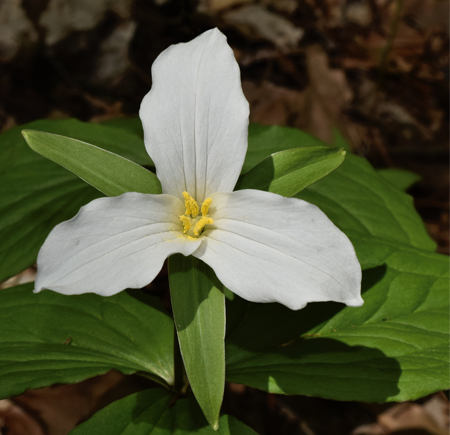 | NATIVE SHADE PLANT Trillium (Trillium ovatum) - Herbaceous perennial rhizome grows with three large leaf like bracts, arranged in a whorl about the scape. This plant bears one flower with three white to purple petals coming off the main stem. Goes dormant after flowers.
- Flowers are white, fading to pink, darkening as they fade. Squirrels and chipmunks eat the fleshy, berry like seeds.
- Found in conifer and mixed forests understory and at openings and edges
|
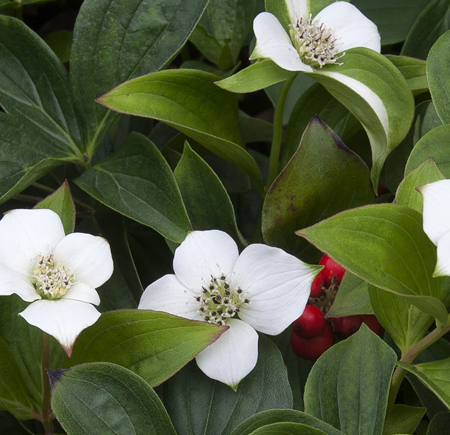 | NATIVE SHADE PLANT Bunchberry (Cornus Canadensis) aka Creeping Dogwood - Rhizomatous herbaceous perennial, 3-8" high bearing white flowers with four petals (May-June), yielding small clusters of bright red edible berries in the fall. The leaves form whorls and are glossy green with whitish undersides, but turn burgundy in the winter.
- Widespread and adaptable. Often found in shade or filtered sun mixed forest with moist to average acidic soils or decaying organic matter.
- Traditionally, First Nations people made tea from this plant to treat aches and pains, inflammation, coughs, fever and fits.
|
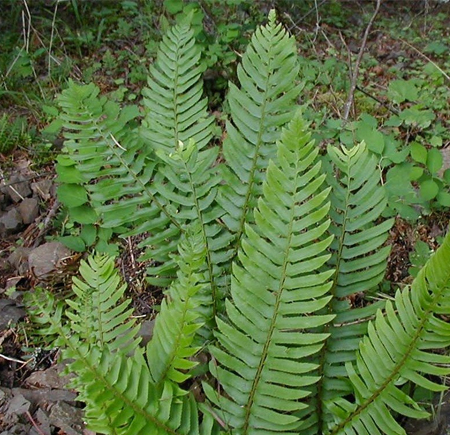 |
NATIVE SHADE PLANT Sword Fern (Polystichum munitum) - Mid to large sized evergreen fern. Large, erect and spreading frowns. Leaf-blades resemble swords. Attractive copper-colored fiddleheads in spring unfurl into tough, waist-high ever-green fronds.
- Found widespread in forests, often on hillsides. Prefers shade and moister soils, though tolerates sun.
- First Nations people used the fronds as bedding or to line berry baskets and steaming pits. The young curled fronds were chewed to sooth sore throats or hasten childbirth.
|
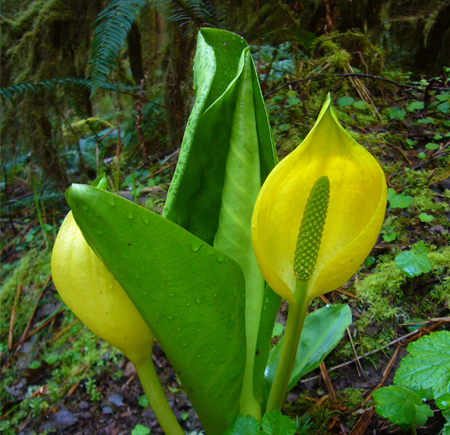 | NATIVE SHADE PLANTS Skunk Cabbage (Lysichiton americanus) - Rhizomatous perennial with large oval waxy, short stalked leaves.
- The flowers are produced in a spadix or stalk with one large bright yellow or pedal like spathe surrounding the flower. It blooms in late winter, early spring and emits a “skunky” odor when it blooms, which also attracts pollinators, scavenging flies and beetles.
- It grows in wet wooded, swampland, along streams and other wet areas.
- Bears eat the roots of this plant after hibernation as a laxative.
- First Nations people did use the flat leaves to line baskets and pits for steaming food.
|
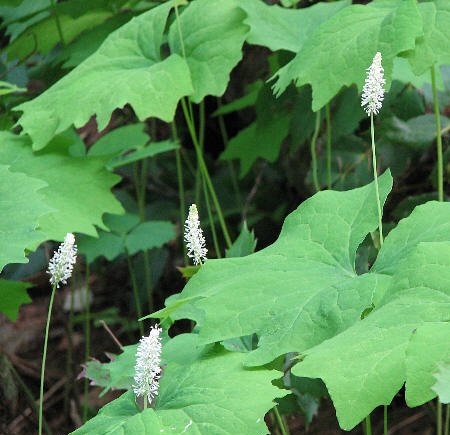 | NATIVE SHADE PLANT Vanilla Leaf (Achlys triphylla) aka Deer's Foot Rhizomal perennial with large clover like leaves, scalloped along the edges. - Tiny white flowers form on the thin, erect stalk
- Prefers shaded, moist sites.
- Dried leaves smell like Vanilla
- First Nations people used the dried leaves as insect repellent and to perfume their homes or in teas.
|
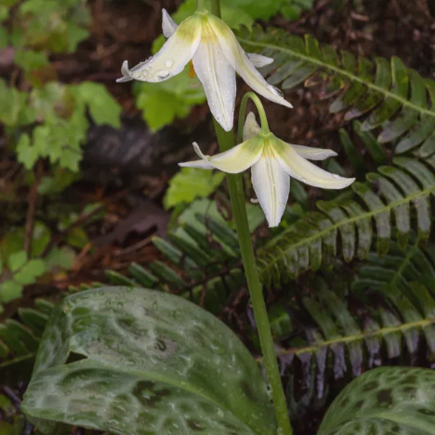 | NATIVE SHADE PLANT Fawn Lily (Erythronium oregonum) - Has white nodding (facing downwards) flower head (often orange-yellow at base inside the flower) with 6 long thin petals gently bending back to point upwards.
- A thin stem raises straight up from the leaves at the base and curves at top near the flower.
- Grow parallel to the ground in pairs from the base of the plant.
- Leaves are often lance-shaped to oblong,
- Grows from a segmented corm (a type of bulb that is covered in hairy bark-like skin) 10 cm underground.
- Found in well-drained meadows and rocky woodlands.
- Can be harvested before it flowers as famine food; however, it said to not palatable and toxic.
|
